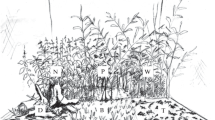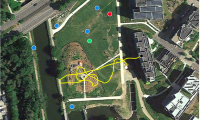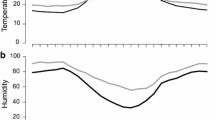Abstract
Observations were made on the activities of workers of the Oriental hornetVespa orientalis, during flight to and from the nest, on fully active days in months of maximal colony activities. Two types of flight out of the nest were recorded: flight for removal of dug-up soil and flight for foraging of buiding materials and food from the field. The flights of digger workers occur and peak around 1200, (with even slopes down to zero on both sides of the peak). The flight activity curve is gaussian and in accordance with the intensity of solar irradiation. Flight activities of foraging workers are limited in the morning hours but subsequently increase, the curve resembling that of the air temperature at 2m above the soil surface. The flight rhythm of digger hornets in the presence of 2 adjacent outles and the rhythm of activity of digger hornets of 2 abutting nests were also investigated. The results indicate a strong competition among the diggers for flight opportunity during periods of highest insolation intensity. Due to the correlation between the flight of digger hornets and the intensity of sun radiation, it is assumed that hornets do make use of solar energy for flight purposes.
Similar content being viewed by others
References
Ashbel, D., A. Eviatar, E. Doron & E. Ganor 1965 Solar radiation in different latitudes. pp. 1–130. The Hebrew University of Jerusalem, Israel.
Ben-Shalom A. & J.S. Ishay 1989 The hornet cuticle as a diode and an electrical source.Physiol. Chem. Phys. Med. NMR 21 (1): 695–106.
Bodenheimer, F.S. 1933 Uber die Aktivitat vonVespa orientalis im jahresverlauf in Palaestina.Zool. Anz. 102 (5–6): 135–140.
Edwards, R. 1968 Some experiments on the rhythmic behaviour of the waspVespula rufa L. (Hymenoptera: Vespidae). MSc. Thesis, Univ. London.
Ishay, J. 1964 Observations sur la biologie de la Guepe orientalisVespa orientalis in Israel.Insectes Sociaux 11 (3): 193–206.
Ishay, J. & N. Croitoru 1978 Photoelectric properties of the yellow strips of social wasps.Experientia 34 (3): 340–342.
Ishay, J. & F. Ruttner 1971. Die Thermoregulation im Hornisennest.Z. veral. Physiol. 72: 423–434.
Ishay, J., H. Bytinski-Salz & A. Shulov 1967 Contributions to the bionomics of the Oriental hornetVespa orientalis.Isr. J. Entomol. 2: 45–106.
Ishay, J.S., B. Perna, Y. Hochberg & M. Goldstein (Asanta) 1980 Photoelectric properties of the yellow strips inVespa orientalis: A mathematical model.Bull. Math. Biol. 42 (5): 681–689.
Ishay, J.S., T. Shimony (Benshalom)., Y. Lereah & T. Duby 1982 Temperature dependence of electrical resistance of hornet and ant cuticle in low temperature: Direct current measurement.Physiol. Chem. Phys. Med. NMR 14: 343–361.
Ishay, J.S., T. Benshalom-Shimony., D. Weiss, & N. Kristianpoller 1987 Luminescence properies of the hornetVespa orientalis cuticle.Physiol. Chem. Phys. Med. NMR 19 (4): 283–294.
Ishay, J.S., T. Benshalom-Shimony & N. Kristianpoller. 1988 Photovoltaic effect in the cuticle of the Oriental hornet. 10th Int. Cong. on Photobiology. Jerusalem.
Iwata K. 1976 Evolution of instinct. Comparative ethology of Hymenoptera. Smithsonian Institution and the National Science Foundation, Washington D.C.
Matsuura, M. 1984 Comparative biology of the five Japanese species of the genusVespa (Hymenoptera, Vespidae).Bull. Fac. Agr. Mie Univ. 69: 1–131.
Matsuura, M. & S. K. Sakagumi 1973 A bionomic sketch of the giant hornet,Vespa mandarinia, a serious pest for Japanese agriculture.J. Fac. Sci. Hokkaido Univ. 19: 125–162.
Manes, A., A. Teitelman & J. Fruehling 1970 Solar radiation and radiation balance at the Central Meteorological Institute, Beit Dagon. Series A (Meteorological. Notes) No. 25. State of Israel, Ministry of Transport, Israel Meteorological Service Research Division. pp. 180.
Potter, N.B. 1964 A study of the biology of the common wasp,Vespula vulgaris L, with special reference to the foraging behaviour. Ph.D. Thesis, Bristol Univ. England.
Roland, C. & A. Harel 1976 Etude de l'approvisionement d'un nid deParavespula germanica: rapport entre activite, rentabilie des recoltes et conditions climatiques.Insects Sociaux 23: 89–97.
Santschi, F. 1911 Observations et remarques critique sur le mecanisme de l'orientation chez les fourmis.Revue Suisse de Zoologie, 19 (13): 305–334.
Shimony, T.B. & J.S. Ishay 1981 Thermoelectric (Seebeck) effect on the cuticle of social wasps.J. Theor. Biol. 92: 497–503.
Shimony, (Benshalom), T. & J.S. Ishay 1984 Electrical capacitance in hornet integument: Frequency, light and temperature dependence; possible P-N junction effects.Physiol. Chem. Physics Med. NMR 16 (4): 333–349.
Schremmer, F. 1971 Versuche zum Nachmeis der Rothblindheit vonV. rufa L.Z. Vergl. Physiol. 24: 457–466.
Spradbery, J.P. 1973 Wasps. Sidgwick and Jackson, London.
Van der Vecht, J. 1957 The Vespinae of the Indo-Malayan and Papuan areas. (Hymenoptera: Vespinae).Zool. Verh. 34: 1–83.
Van der Vecht, J. 1959 Notes on Oriental Vespinae, including some species from China and Japan. (Hymonoptera: Vespidae).Zool. Meded. 36: 205–232.
Von Frisch, K. 1950 Die Sonne als Kompass im Leben der Bienen.Experientia 6 (6): 210–221.
Wilson, E. O. 1971 Insect societies. Belknap Press, Harvard, Mass.
Yamane, Sk. & S. Makino 1977 Bionomics ofVespa analis insularis andV. mandarinia latilineata in Hokkaido, Northern Japan, with notes on vespine embryo netst (Hymenoptera: Vespinae).Insecta Matsum. 12: 1–33.
Author information
Authors and Affiliations
About this article
Cite this article
Ishay, J.S., Elly Lior, S.(. Digging activity by the oriental hornet (Vespa orientalis; Hymenoptera, Vespinae) is correlated with solar radiation. J. Ethol. 8, 61–68 (1990). https://doi.org/10.1007/BF02350275
Received:
Accepted:
Issue Date:
DOI: https://doi.org/10.1007/BF02350275




